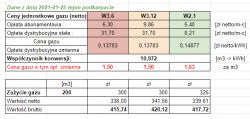Sorry gentlemen, I used a significant shortcut :)
Quote: I choose W3.6 because it is the cheapest.
it referred to the fact that PGNiG would take me to the higher tariff of the current W2.12 anyway, so the abbreviation referred to W3.6 and W3.12T. Sorry for the confusion.
I understand that it is generally much more expensive than in W2.12 because the increase in costs is associated with a significant increase in the subscription fee.
The prices I gave were obtained from BOK and are for the vicinity of Rzeszów, so they may differ for other regions of the country and the comprehensive agreement cannot be compared to a standard customer - although the "gas region" is the same. Then the prices will be lower.
Quote: Summing up, I can think of the saying that he changed the uncle from the hatchet to the stick

Maybe, and maybe not - in the context of a source of warmth and comfort.
When switching from coal dust to gas, I expected an increase in costs, but on the other hand I was fed up with burning fine coal.
I would like to add that it is an upper combustion boiler with ECO certificate without a feeder.
Due to the EU, he was withdrawn from the market, which is a pity because I would probably continue to smoke unknowingly that you can be more comfortable ;)
The proverbial "Something for something".
Generally speaking, coal dust was 4 tons for the season, which cost PLN 2,240, and pea coal would cost from PLN 2,800 to PLN 3,200
I don't have underfloor heating, but radiators, so the gas consumption will be higher.
From January 6, the boiler burned 230 m3, which in these prices comes out at W2.12 ~ PLN 478 and for W3.6 ~ PLN 471.
Including hot water and cooking.
In this way, PGNiG will transfer me to W3 after the April lecture (end of the contract and lecture).
x - which
x better?
Currently, the boiler burns an average of 9.6 m3 / day, and even if it burned 15 m3 (it burned in -14o) per day for a month, the bill would be about PLN 900.
I prefer to add 100-150 PLN / month and sit in the heat, not shovel the coal and add ash :)
Based on previous measurements, I assumed that in the summer, hot water and cooking will be needed about 40 m3 / month.
I estimated that the total cost of gas for the whole year would be about PLN 2,900 - heating, hot water and cooking.
So far, I have paid for gas about PLN 740 / year (about 25 m3 / month), which means that the real heating will be about PLN 2160, which is slightly cheaper than smoking or with peas.
In addition, savings on water, canal and electricity only approx. PLN 120.
Has there been an increase in costs?
I think I changed it well - for the moment ;)
Quote: Annual consumption determines whether you belong to a given tariff, so if you have less than 1200 m3 during the year, you will be in W-2 from the machine in the next year.
It's just that I wrote about the comprehensive agreement at PGNiG, and what oddity you chose or what you gave yourself to squeeze in by a trader, that your rates are overstated, I do not know.
I know that consumption decides and that's why I wrote that they will transfer me from the machine. I did not choose anything when the annex to the contract came, then I will decide. Rather, it is impossible to negotiate rates.
PS I am going to take advantage of the "Clean Air" program, so part of the investment will come back.
Thanks for your comments






